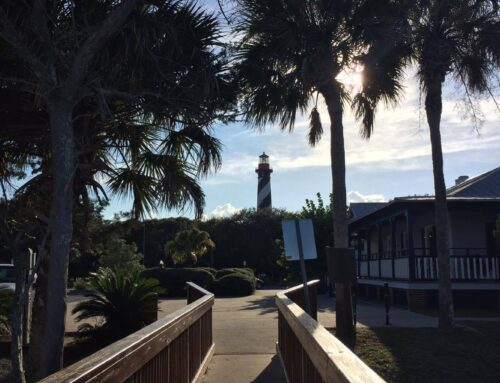When you’re looking for things to do in St. Augustine, it isn’t unusual to have our beaches at the forefront of your mind. Florida’s Historic Coast is home to a total of seven sandy shores which offer a degree of privacy that simply cannot be matched by other Florida beaches, making St. Augustine beaches among the most unique in the world. But, even on the sunniest beach days, vacationers and residents should have beach safety on their mind.
1. The Sun
Long periods of time exposed to the sun is dangerous and can cause sunburn, aging skin, wrinkles, cataracts, a weakened immune system, and skin cancer in severe cases. In fact, according to the CDC, skin damage can occur in as little as 15 minutes from unprotected exposure to the sun.
There are several ways to protect yourself from the sun. The most common method is applying sunscreen liberally and often. Other methods include wearing a hat, sunglasses, and extra clothing, minimizing the time you spend under direct sunlight and avoiding the highest levels of UV exposure, occurring between the hours of 10:00 am and 3:00 pm.
2. Lifeguards
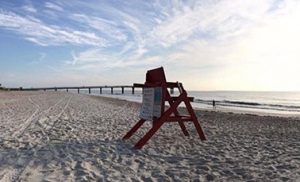
In 2012 St. Johns County was awarded the 2012 Beach Patrol of the Year by Florida Beach Patrol Chiefs Association – the highest award given. With the help of four year-round Fire and Rescue personnel, 20 firefighters who are trained in Marine Rescue, and 80 seasonal lifeguards, St. Johns County has established nearly flawless life-saving standards.
Lifeguards are stationed along various stretches of beaches throughout St. Johns County from the beginning of May until the end of September. However, the 2018 schedule of lifeguards on duty is not yet available.
3. Beach Warning Flags
Red Flag: In the case of a red flag, St. Johns County recommends that beachgoers stay out of the water, but it is not mandatory to do so. A red flag can mean a number of things including a very high surf and dangerous currents.
Two Red Flags: Swimming is prohibited.
Yellow: A yellow flag means that the ocean waves are rougher than normal. Swimming is allowed but beachgoers should be on alert for undertows, potentially high surf, and dangerous currents. If you must go into the ocean, it is best to do so in the presence of a lifeguard.
Yellow with Black Dot: Surfing is prohibited.
Green: A green flag represents safe water conditions, but swimmers should be on alert even on the sunniest and calmest beach days.
Blue/ Purple: When sharks, dolphins, jellyfish, and other marine life are spotted nearby the shore, officials will raise a blue or purple flag. You may swim while these flags are up, but, they may be combined with other flags to prohibit swimming.
4. Marine Life
At times, sharing the ocean with marine life is dangerous. St. Augustine beaches are home to an array of beautiful sea animals: sea turtles, jellyfishes, stingrays, sea urchins, saltwater catfish, algae blooms, barnacles, sharks, dolphins, manatees, and lizards. It is important that you do not touch any marine life you encounter because they may bite, sting, or carry bacteria like Salmonella.
Marine Life Laws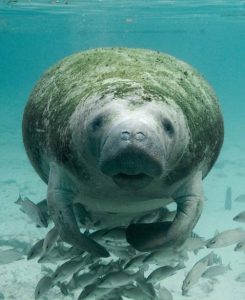
Manatees: Touching a manatee is a misdemeanor, penalized with up to 60 days in jail and a $500.00 fine. This law is taken very seriously because they are an endangered species.
Sea Turtles: Touching a sea turtle is illegal, penalized with up to one year in jail with fines up to $25,000.00. This law is taken very seriously because they are an endangered species.
Note: If you notice an animal in distress while you are in Florida, you are encouraged to report it. Report findings to the Florida Fish and Wildlife Conservation Commission at 1-888-404-3922. Be prepared to answer the following questions:
- What is the exact location of the animal?
- Is it alive or dead?
- What is the approximate size of the animal?
- Is it marked with spray paint or other markings?
5. Sea Turtle Season
In St. Johns County, Sea Turtle Season is from May 1st to October 31st. Beachgoers must pay special attention to sea turtles, hatchlings, and nests. The following restrictions are in place during Sea Turtle Season: Driving and parking on the beach are prohibited before 8:00 am and after 7:30 pm, drivers are required to turn their lights off or dim their lights if its dark, beachfront properties are required to dim their exterior lights, flashlights and lanterns are prohibited.
6. Tidal Flooding
Tidal flooding occurs when high tides flood inland streets.
7. Rip Currents
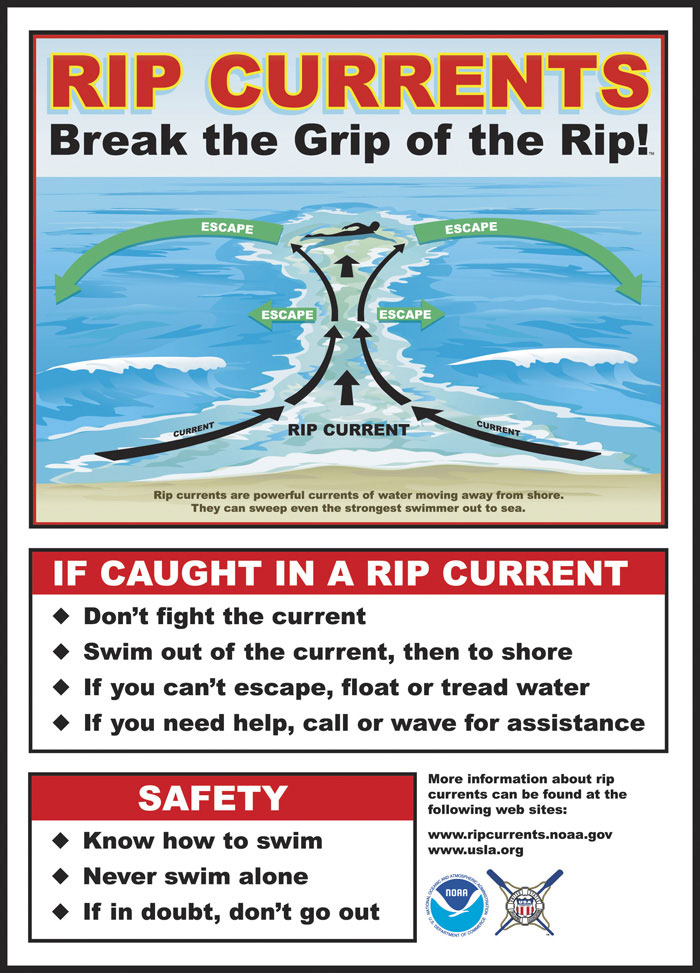
Photo Credit: NOAA
Rip currents are a powerful current that flows vertically from the beach through the surf zone instead of horizontally. Although rip currents do not pull swimmers underwater, they are dangerous because they carry swimmers away from the shore and have powerful undertows.
If you find yourself caught in a rip current, do not panic. Wave your hands to get the attention of a lifeguard. If there are no lifeguards on duty, let your body float out of the current and swim directly towards shore.
How to Spot a Rip Current
Rip currents move rapidly out to sea creating a foamy and choppy surface. They are darker than surrounding seawater because the strong undertow disturbs and carries sand, seaweed, and other findings from the ocean floor, creating a brown murky look. All rip currents cause a break in the ocean, but they are difficult to spot when you are at sea level and are most noticeable from higher ground, like a beach access point.
Note: St. Johns County recommends that swimmers be able to swim an overhand stroke for 15 minutes if they plan on going in the ocean above their knees.
8. King Tide
King tide is a non-scientific phrase and a newer concept, they are the highest high tides and lowest low tides of the year. The Sun and Moon both have a gravitational pull, but, on nights of a full or new moon, the Sun and Moon are aligned causing a more powerful gravitational pull in one direction or opposite directions, leading to king tides.
During a high king tide, beachgoers can expect beachfront and inland flooding. During a storm and a high king tide beware of extreme storm surges that can lead to property and vehicle damage.
9. Bacteria
Once in a great while, St. Johns County may have a swimming advisory because of high levels of bacteria in the sea water. These levels of bacterias are due to stormwater runoffs, pet, wildlife, and human sewage caused by hurricanes, nor’easters and other stormy weather.
10. FAQ: Beach Information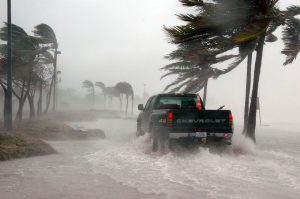
What is the surf zone?
The surf zone is the area between the high tide and where the waves break in the ocean.
What is a rip current outlook?
A rip current outlook is the expected forecast of rip currents.
How big are rip currents?
Rip currents usually range from ten to 20 feet, but some are up to ten times larger.
Where should I look for rip currents?
Rip currents are frequently found in low spots, breaks in sandbars, and near structures such as piers and groins.
Should I report all deceased marine life?
You do not have to report all deceased marine life but St. Johns County asks that you report deceased endangered species such as sea turtles and manatees.
Disclaimer: Every effort is made to ensure the accuracy of information on the City Blog.
Sharing and re-posting this blog is encouraged. Please credit OldCity.com when sharing.
Photo Credit: NOAA, OldCity.com







